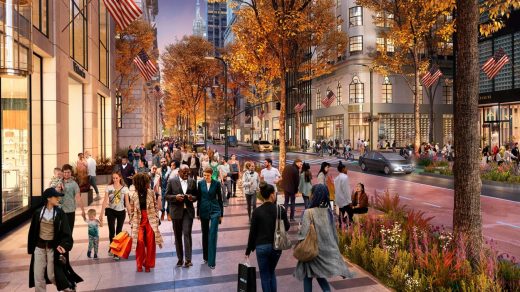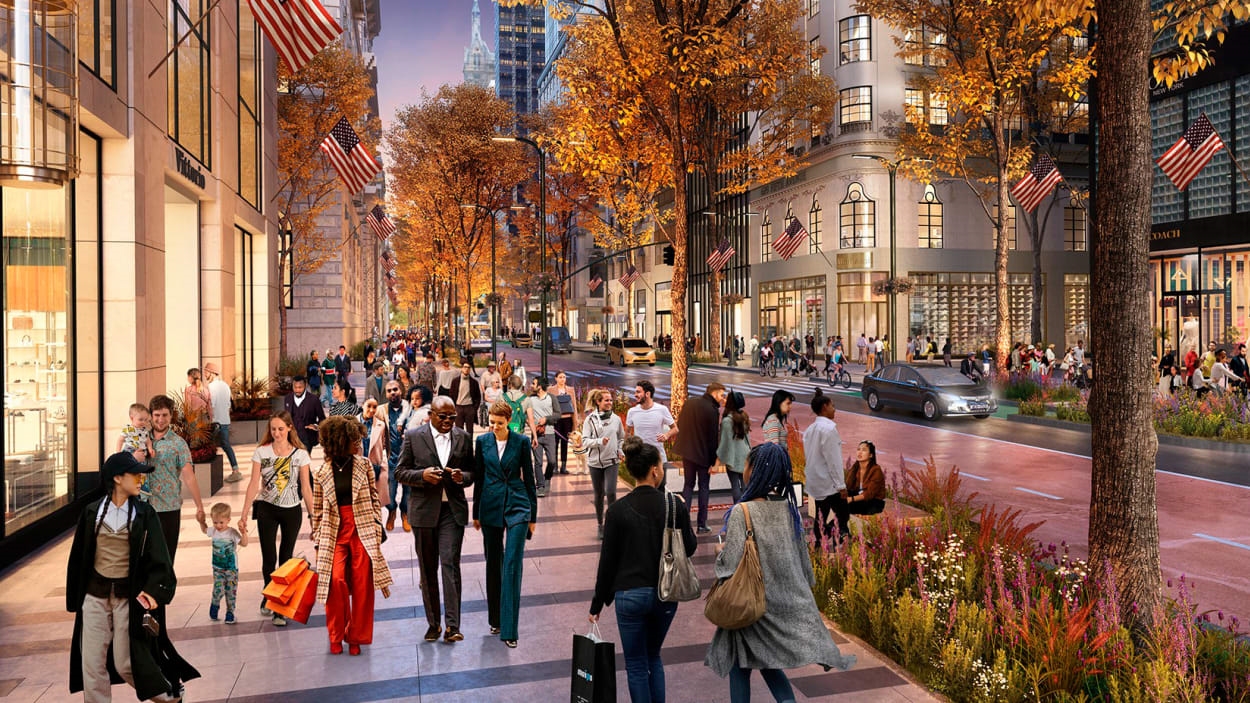Manhattan’s Fifth Avenue redesign should be celebrated—then replicated
By Elissaveta M. Brandon
Fifth Avenue is getting a long-overdue makeover. On December 18, New York City Mayor Adams announced that Manhattan’s iconic corridor—or at least the most famous stretch of it between Bryant Park and Central Park—will be reimagined as a “safer, less congested, pedestrian-centered boulevard that also prioritizes cyclists, mass transit, and the public realm.”
The city is yet to contract a design firm, and construction isn’t expected to complete until 2025, so dissecting the current proposal as it stands would be a fruitless exercise. But even this early on, one thing is clear: Fifth Avenue carries a lot of clout. And even though this particular proposal is clearly meant to generate even more revenue on a boulevard where tourists drop tens of thousands of dollars at high-end retailers like Valentino, Tiffany and Co., and Cartier, it could prove a useful case study for other neighborhoods, where locals have long pined for fewer cars and more public infrastructure like bike lanes, bus lanes, and bigger sidewalks. (Fifth Ave is allegedly getting all three.)
To be sure, a dedicated bus lane on Fifth Ave could help locals, too. According to Eric McClure, executive director at the local non-profit StreetsPAC, if the proposal helps speed up buses, it could benefit 50,000 or so daily riders of four bus lines that currently average 5 mph. And, he adds, “more sidewalk space and fewer motor vehicles will mean a lot for the thousands and thousands of workers whose offices are along or near Fifth Avenue.”
The Fifth Ave redesign has been an empty promise for over two years. The most recent proposal, however, builds on a sweeping Open Street initiative that recently closed the boulevard to traffic from 12-6pm for three Sundays in a row this holiday season. The initiative attracted thousands of people who took to the streets and promptly documented their experience on social media.
The images brought to mind a concept known as induced demand, an economic phenomenon in which increased supply lowers prices and therefore increases demand of a good. When applied to urban planning choices like expanding or building more highways to alleviate congestion, it often has the unintended effect of bringing more drivers to the road—and with it, more congestion. So, if you close a street to traffic, or widen the sidewalks as the city plans to do alongside this stretch of Fifth Ave, will the roomier sidewalks simply attract more people? Ben Crowther, advocacy manager at the non-profit America Walks, says that induced demand can be applied to all types of city infrastructure. “If you build it, they will come,” he says, but in the case of wider sidewalks, the benefits outweigh the cost.
Here, the benefits abound. First, fewer cars means safer streets. Streets that are designed for people (not cars) can also foster interaction and enhance a sense of place. Studies also show that cyclists and pedestrians spend more at local businesses than drivers, which makes the Fifth Avenue redesign a solid economic development proposition. “We all think of the success of the main street and the subsequent lament at the decline of main street because we hollowed those places out for big roads,” says Crowther. “Making them walkable again really has the power to revive local economies and get people spending money locally and enjoying themselves while doing so.”
Fifth Ave, of course, doesn’t exactly need “reviving”—at least not in the economic sense. According to a recent Cushman & Wakefield report, it’s even ranked as the most expensive shopping corridor in the world, with rents surpassing pre-pandemic levels. What does need reviving is other parts of the city like Southern Boulevard in the Bronx, or parts of Queens where bike lanes remain incredibly sparse. Both Crowther and McClure think that Fifth Avenue has enough influence to spur similar treatments elsewhere in the city. “It’s critically important that the city prioritize equity in its approach to create more and better public space,” says McClure.
At the end of the day, Fifth Avenue will never not be crowded, but at least people will be dodging other people, not cars. 75% of New York City streets are dedicated to cars (including lanes and on-street parking) and less than half of all households own a car, “so there’s this extreme imbalance between how decision makers have allocated public space in the streets of New York City versus how people in New York City usually get around,” says Crowther.
If the city’s top avenue swaps cars for dedicated bus lanes and larger sidewalks, that step should be celebrated. And then duplicated.
(8)



